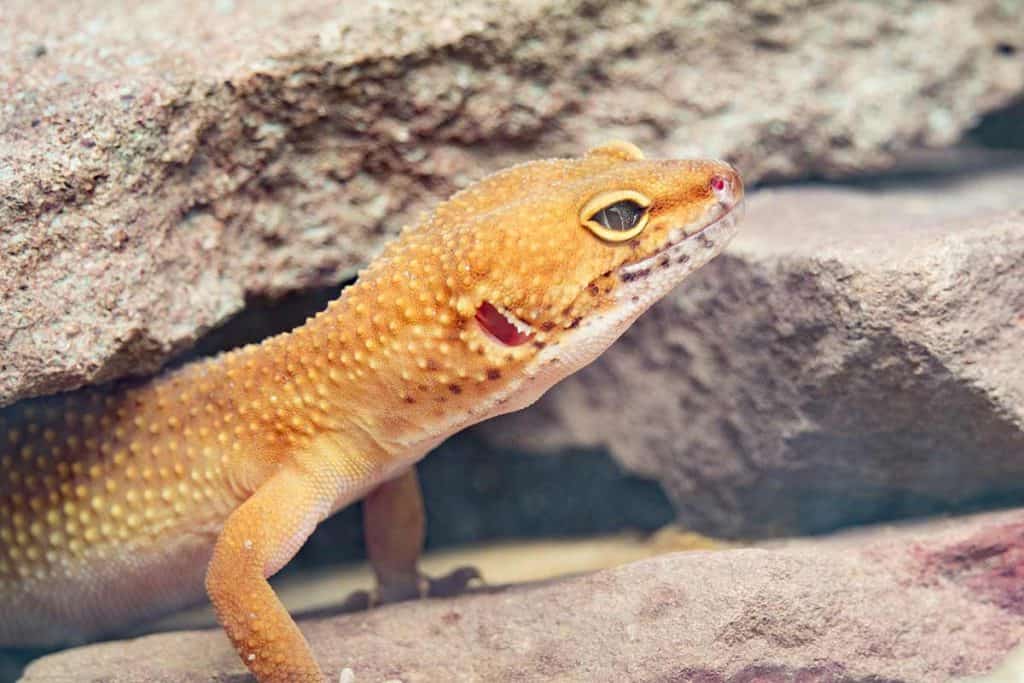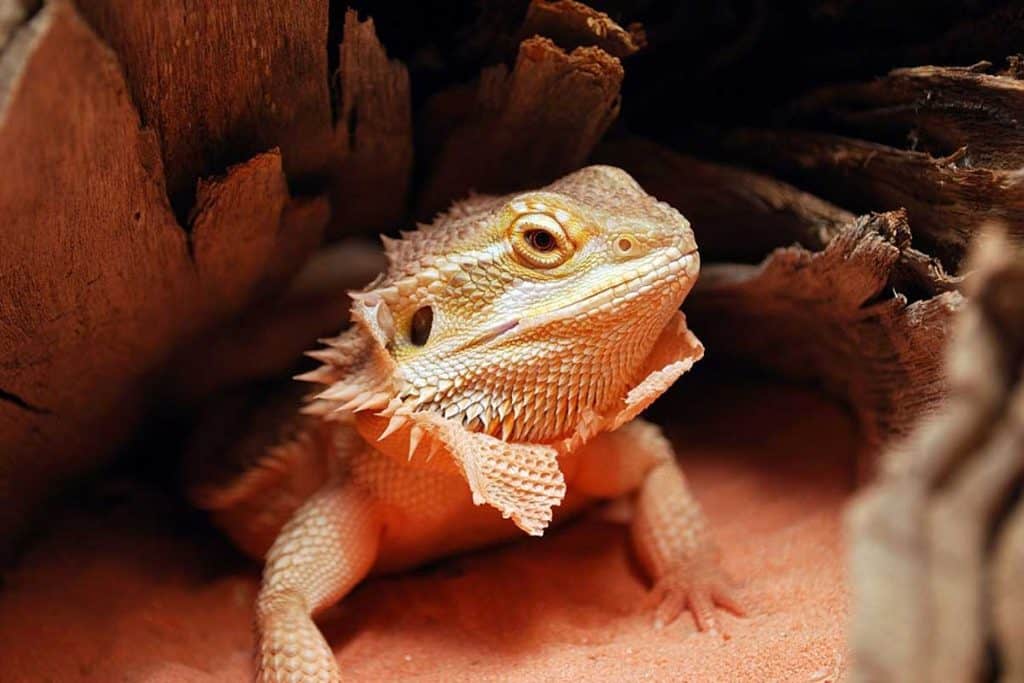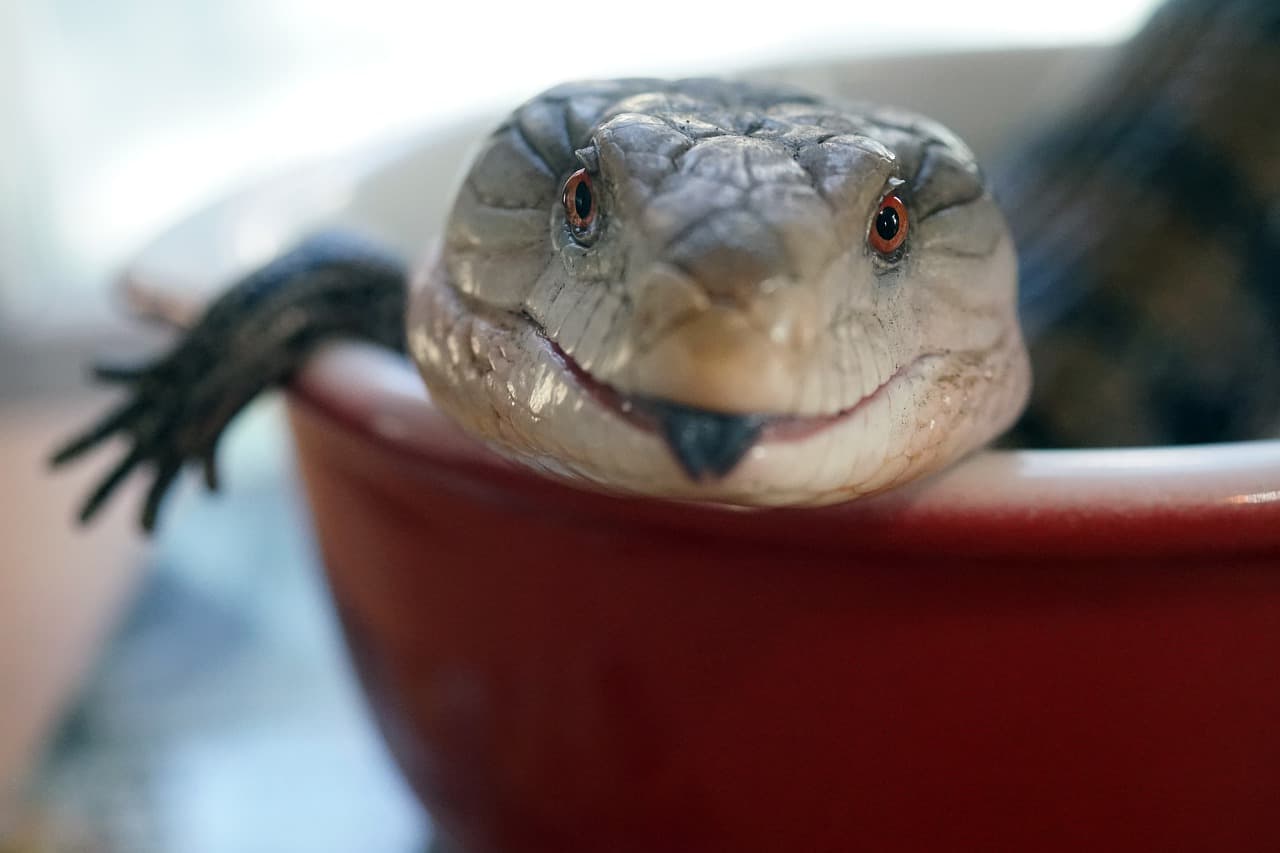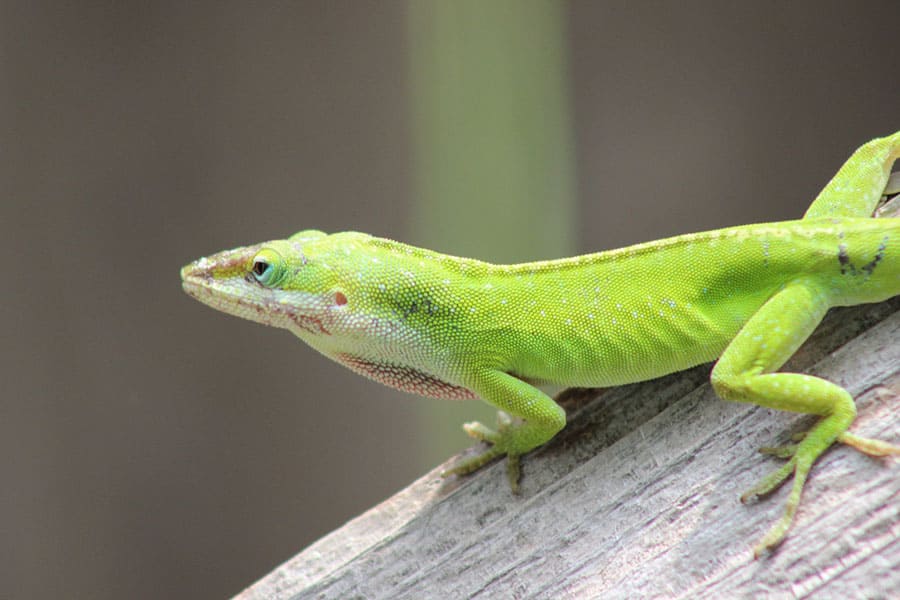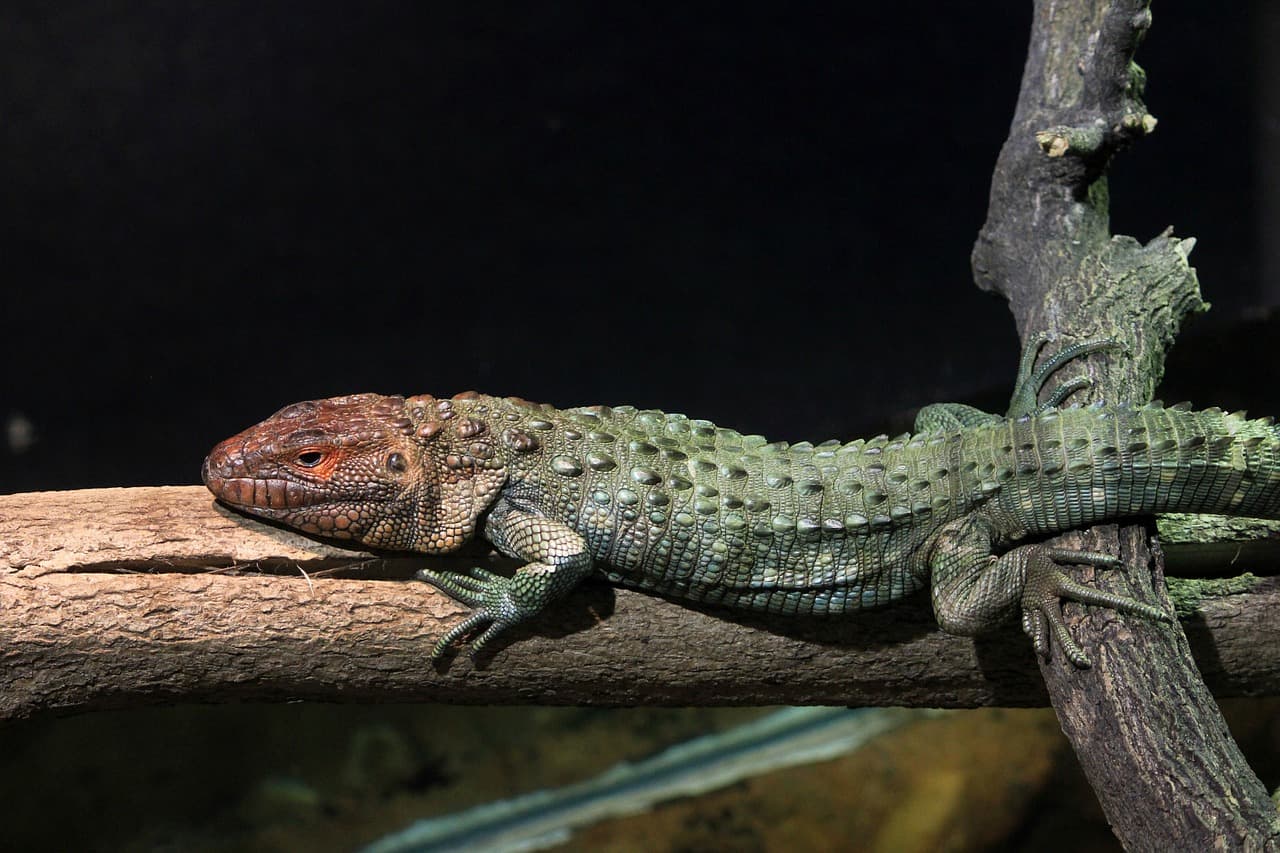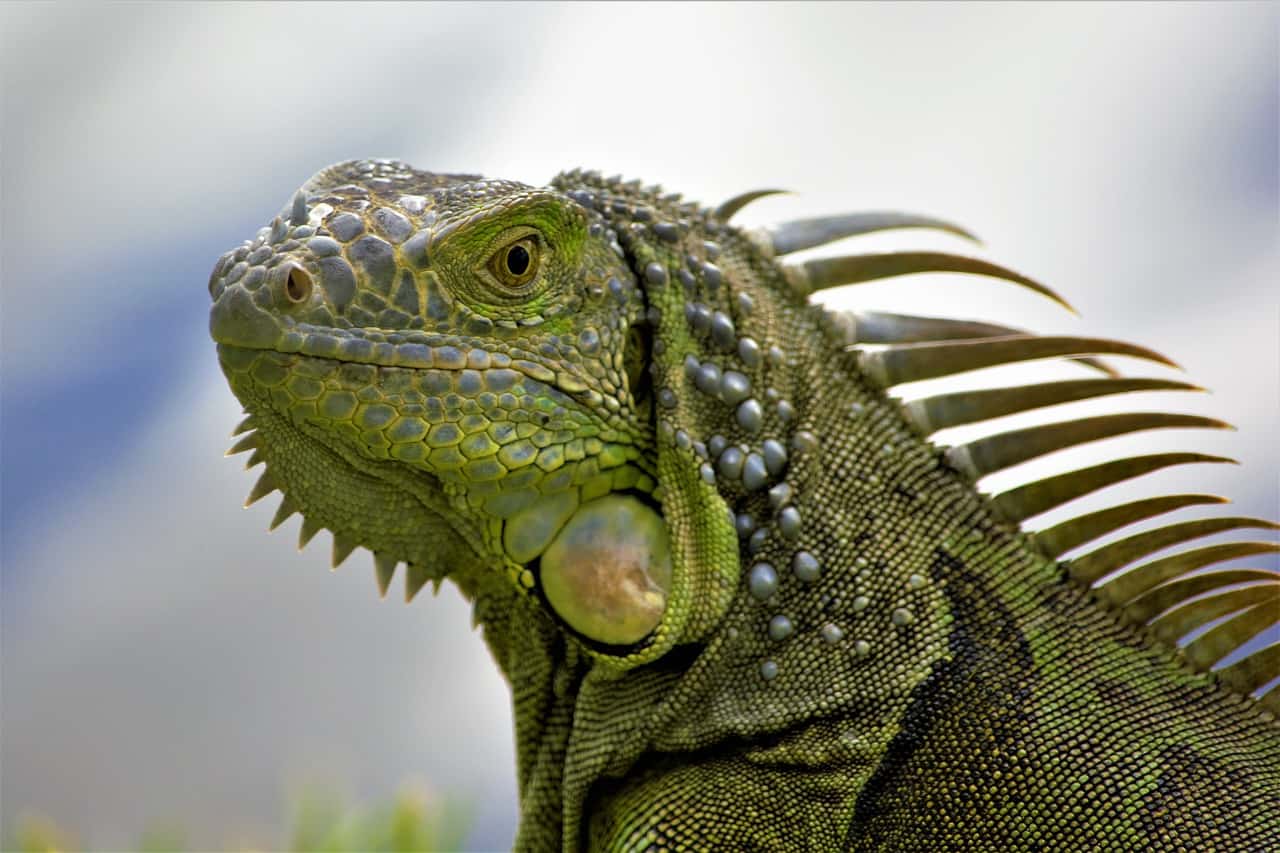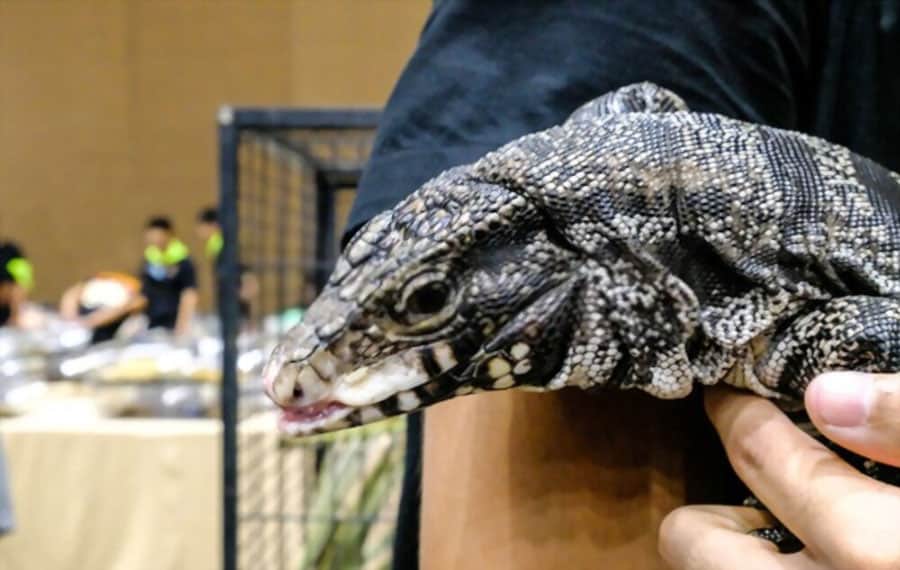Starting your journey as a new lizard parent is super exciting, and we are honored to help you along the way! Choosing the best lizard as a beginner can seem scary, but there are many great choices out there that will suit your specific needs as a newbie herper, such as leopard geckos, anoles, and bearded dragons.
We’ll also cover several factors you will need to consider before diving into buying a lizard, like cost and space, and the time you’re willing to commit to its care.
We’ll go over these considerations in more detail soon. Once you have determined how much time, money, and space you are willing to commit to your new pet, you can have a look at our top picks for the best lizards for beginners below.
The Best Pet Lizards for Beginners Are
We’ve chosen these lizards based on their hardiness and ease of enclosure setup. They are in no particular order because they are all great pets suited to different lifestyles, preferences, and needs.
1. Bearded Dragons — Best Pet Lizard for Newbies
Bearded dragons are an absolute favorite of many beginners and experienced reptile lovers. They can be a bit pricier than other beginner lizards because they have been bred to have specific morphs and temperaments.
Bearded dragons can range in price from $50 to over $800 depending on their species and color morph. Here is our comprehensive guide on all of the costs involved with owning a beardie.
Bearded dragons are territorial, solitary lizards and should be housed individually. They are omnivores and eat a mixed diet of live crickets, greens, and vegetables.
If they are socialized properly, they love to be snuggled and can form close bonds with their owners. Their temperaments are generally more laid-back and friendly than most lizards, making them an ideal choice for beginners.
These lizards grow to between one and two feet in length and will typically live for around 10 to 12 years.
2. Blue-Tongued Skink
Blue-tongued skinks are friendly and hardy lizards, which makes them easier to handle and less fragile. True to its name, blue tongue skinks have brightly colored blue tongues! It sticks it out to predators to ward them off.
These lizards cost on average between $150 and $300, with certain rarer varieties costing as much as $800. They only reach about 20 inches in length, but they are chunky lizards. They are omnivores and require a varied diet of plant material and meat such as juicy worms or rat pinkies.
Blue tongues love to burrow, so make sure to have an enclosure deep enough to have a layer of substrate that will let them dig to their heart’s content. While loose substrates should generally be avoided, they are actually ideal for this species.
They are loving lizards and have excellent natures, which makes them great beginner lizards.
Blue-tongued skinks can live up to 20 years.
3. Leopard Gecko
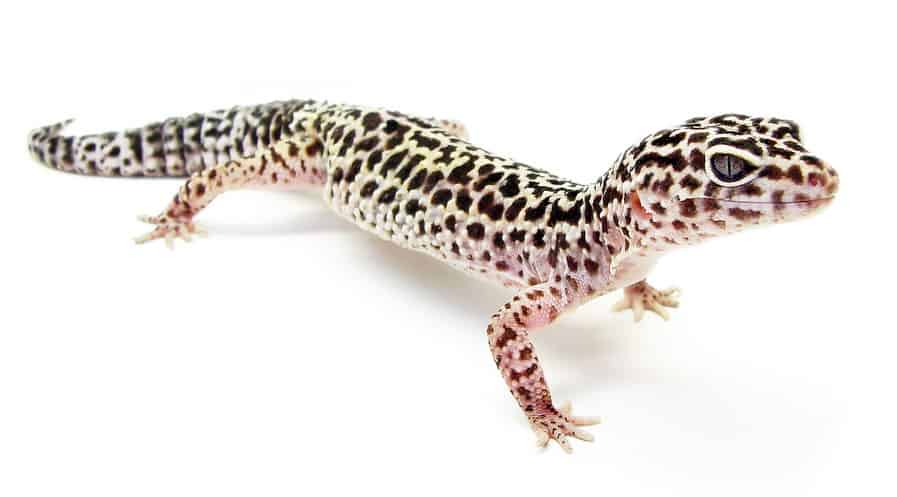
Leopard geckos are beautiful and quirky lizards that are incredibly popular amongst beginner reptile enthusiasts.
These lizards can cost anywhere from $40 and $450 depending on the morph, though most basic morphs only cost around $60 at most. They do great with handling if socialized from an early age and very rarely bite or show aggression.
One of the best features of a leopard gecko is that you can actually hear them! They vocalize their feelings with chirping or barking sounds, especially if they are hungry or hunting prey. Keep in mind they are mainly nocturnal lizards, so having their enclosure in your bedroom will mean that you may occasionally be serenaded in your sleep.
Leopard geckos do not need very tall enclosures because they do not climb very high. They do not have the sticky pads on their toes like most other geckos.
These lizards are strict insectivores, so you need to be comfortable handling live crickets and other insect goodies to keep them healthy. They are quite small and only grow up to around 8 to 12 inches at most.
Leopard geckos can live anywhere from 10 to 15 years.
4. Green Anoles
Green anoles are great for someone who wants a small display lizard with basic care requirements that takes up a small amount of space. They are especially great for beginners who want to get an idea of how to care for a more basic lizard before moving on to something more costly and time-consuming to care for.
Since they are so small, green anoles only need a 20-gallon enclosure. They typically reach about eight inches in length.
On average, they only cost between $10 and $20. They are quite short-lived with an average lifespan of about three to six years.
These lizards do not do well with or particularly enjoy frequent handling, so if that is what you are after, then the green anole is not the starter lizard for you. However, they are quite handsome to observe, with vibrant green scales and bright red dewlaps, which makes them stunning display lizards.
5. Uromastyx
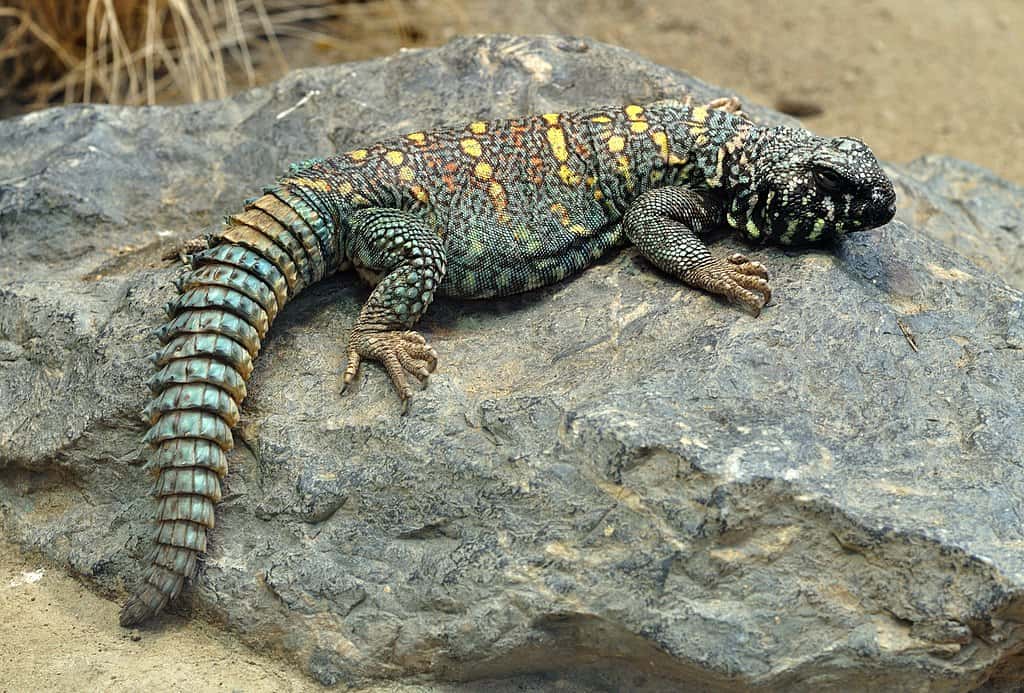
These dinosaur-like spiny-tailed lizards are a perfect choice for a beginner who wants to handle their lizard. On average, they cost anywhere from $100 to $300. They aren’t very long, as they typically only reach about 16 inches in length, but they are quite chunky, hardy lizards, which makes them easy to handle.
They are natural desert-dwellers and will require a substrate that they can burrow into to feel safe and secure. Keep this in mind when you are looking for enclosures and the space you have available.
Uromastyx are primarily herbivores that can occasionally snack on an insect. They do not have to have insects in their diet, but they do need a
They live for around 10 to 20 years, and some have been recorded to reach 30 years! Make sure you are ready for a long-term commitment if you purchase a uromastyx.
6. Gidgee Skink
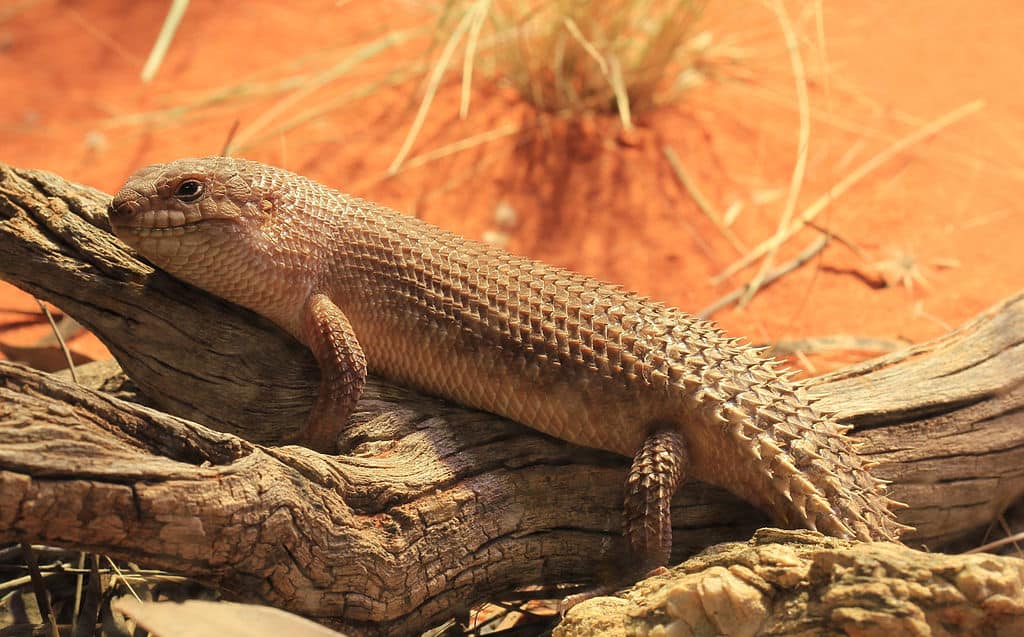
The Gidgee skink is perfect for a beginner who wants a group of lizards that will live together in harmony. These lizards like it hot and will need quality basking bulbs to get their basking area up to 105°F.
One caveat to the Gidgee skink is their cost. They are very expensive at around $500 to $2,000! However, they do usually live for over 20 years, so you can consider them a long-term investment.
They do not do well with handling because they are very fast and somewhat skittish, so they are best left alone as a display lizard. This is ideal for beginner reptile keepers who want a lizard they don’t have to handle.
They reach about 10 inches in length but are chunky lizards. They eat a healthy omnivorous diet that includes insects and lots of veggies.
If you are willing to take on a rather pricey but long-term investment in exchange for a handsome, fascinating lizard, then the Gidgee skink is for you.
7. Crested Gecko
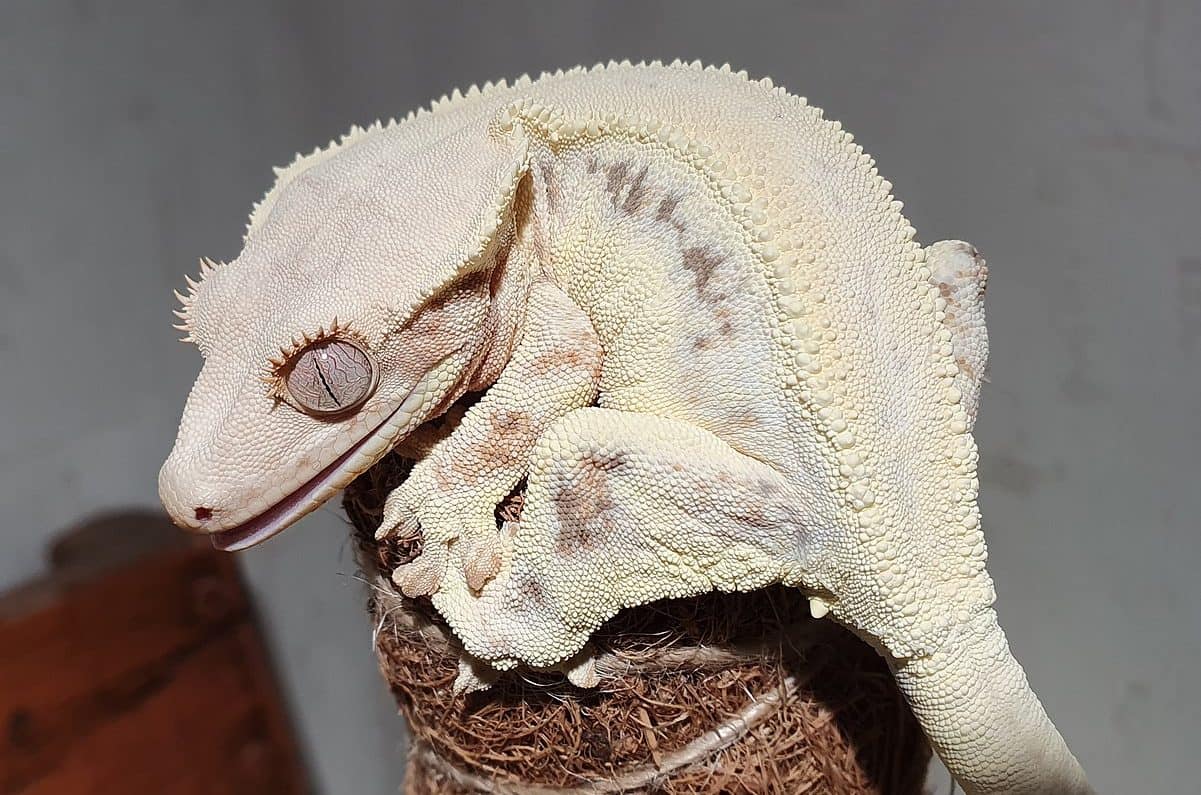
Crested geckos have small spines over their eyes that look like little eyelashes or crests, which gives them a unique look that makes them very popular among herp enthusiasts.
These New Caledonian lizards love the vertical climb. They need an enclosure with lots of climbing room and plant cover. You can use real plants or synthetic plants to provide them with the cover they need. Silk plants work best because they are easy to clean.
Crested geckos do not need very complicated lighting setups or heating contraptions because they are nocturnal animals. They are very low maintenance. Additionally, they are slower than most other species of geckos and generally enjoy being handled.
Crested geckos cost between $30 and $300 depending on their morph and age. They grow to about eight inches in length which makes them small and easy to handle.
Crested geckos typically live to about 10 to 12 years old.
8. Caiman Lizard
If you are looking for a big, brightly colored lizard, then the caiman lizard is for you! They grow to two to five feet in length and have some heft to them. If they are properly trained and socialized from a very young age, they can tolerate and even enjoy a little bit of consistent handling.
However, they generally enjoy being left alone. They will thrive in a big enclosure where they can climb, run around, and soak their bodies in water.
They are fantastic swimmers, beautiful to watch, and very active. When they are in the water, you can feed them the meatier part of their diet by offering them live feeder fish, clams, snails, and small crawfish.
Caiman lizards are more expensive than most of the other lizards on this list, but they’re worth it. They sell for between $300 and $1,000 depending on the breeder they are purchased from and the vibrancy of their coloring. If you want a gorgeous and active lizard to watch all day long but handle very rarely, then this is the one for you.
Caiman lizards can live for up to 10 years.
9. Green Iguana
Green iguanas are incredibly popular beginner lizards because of their easy diet and eventual handleability. They are strict herbivores, so if you are not into feeding live prey or handling insects, then this iggy is perfect for you.
They are quite large lizards, reaching about six feet in length. The handling process will take patience and a lot of dedication from you, and you’ll need a very large enclosure to house them in.
They must get used to your home and you before you start handling them. Then the handling and socialization process needs to be consistent, brief, and gentle until they get used to it. Once they are tame, however, they make wonderful, docile companions.
The slight downside to handling them is the size of their claws, tail, and mouth. Their claws and tails are very sharp and can do unintended damage to you if they are frightened. They can also give a nasty bite if they are stressed or feeling aggressive.
On average, they cost about $30 to $50, so the lizard itself is cheap. However, as we briefly mentioned above, they need a very large enclosure that allows them to climb vertically. They also need constant access to a water bath that is big enough for them to soak their entire body in all at once.
Green iguanas can live for up to 30 years, so be prepared for a long-term companion if you choose this lizard.
10. Argentine Black and White Tegu
If you want an energetic, rambunctious, dog-sized lizard, then have a good look at the Argentine black and white tegu.
On average, this tegu costs anywhere from $140 to $400. They are small as babies, though they grow to be very large, so they need large enclosures. In addition, their food costs can be high, so be prepared for a more costly journey if you adopt one of these lizards.
This tegu reaches about four feet in length and can become quite bulky. This makes them easily handled with plenty of proper socialization from an early age, and they do enjoy a good snuggle against their owners. If they are raised with care and are tamed properly they are not prone to aggression or biting.
However, if they are not handled from a young age and tamed properly, they can become quite vicious and aggressive, so be prepared to spend a lot of time with this lizard. They are large lizards with large mouths full of sharp teeth.
One great thing about this particular type of tegu is its intelligence. Argentine black and white tegus are highly intelligent and sociable.
They enjoy burrowing and should have access to blankets or substrates that allow them to burrow and hide away from direct heat and stressful situations whenever they wish.
They do need bigger protein sources such as mice and small rats or chicks. If you are not able to spend the kind of money on their dietary needs or are squeamish about feeding your pet live prey, then this might not be the lizard for you.
Argentine black and white tegus live on average anywhere from 15 to 20 years old, so they are a costly and long-term investment, but they are very rewarding to care for.
What You Need to Consider Before Buying a Lizard
Initial Investment Cost
The first thing you’ll need to consider is the initial investment of purchasing your lizard, its enclosure, and the things they’ll need to furnish the enclosure, such as basking bulbs, UV bulbs, and decorations for enrichment.
Lizard Price
Lizards range in price depending on their popularity and their availability. Beginner lizards are usually quite popular, and so the demand for them makes them readily available, which helps keep their prices down.
When you purchase your lizard, make sure you are getting it from a reputable breeder or a reptile expo. You need to be selective when choosing your pet because not all breeders and shops maintain the same level of hygiene and good husbandry practices.
Just like dogs and cats, you can often adopt lizards from local and online shelters. Going through an adoption process can sometimes mean that you will have an expert interview you and potentially even do a house check to verify that your enclosure setup is perfect and you’re willing and able to properly care for your new pet.
Adopting a lizard is a good idea if you want to keep your initial investment cost low. The only downside to adoption is you are not guaranteed to get a baby lizard, and you may need to search for a while to find the species you want. Additionally, the shelter may not have all of their medical history information available or know where the animal came from.
Enclosure
Once you have decided on what lizard you want to get, you will need to purchase and set up its enclosure before you bring it home. Most lizards need quite a bit of space (anywhere from 20 gallons to 40+ depending on their species), so they need an appropriately sized enclosure.
Essential Accessories
Most lizards like it hot and will need good quality basking bulbs and hoods to mount them inside their enclosure. Some lizards also benefit from additional heating pads or ceramic heating elements to warm the rest of the enclosure. These need to be connected to a thermostat to constantly monitor and regulate the temperature gradient of the enclosure.
Some lizards require less humidity, while others need a little more. You do not need a misting system, but you do need a hygrometer that will measure the humidity of the tank to make sure your lizard is living in a comfortable environment.
The substrate for your lizard’s enclosure does not have to be anything fancy, and it is best to avoid loose substrates in most cases to avoid impaction. Bioactive setups should only be attempted by experts, as they require a lot of upkeep and can be costly to maintain. Reptile carpet is a good and affordable choice, and you can easily clean it to extend its lifespan.
Lizard Name
What are you going to name your pet? We have a few ideas.
Upkeep Costs
Once you’ve purchased your lizard and set up its enclosure, you’ll need to think about the cost of feeding and maintaining your new pet’s habitat for years to come.
Nourishment
The biggest upkeep cost of owning a lizard is food. Insects like crickets and worms and plant material like vegetables and fruits are all necessary for an omnivorous lizard’s diet. If you choose to get a herbivorous lizard like the green iguana, then fresh greens and veggies are required daily.
On top of the food requirements, most lizards need
Lights
UVB lights will also need to be changed roughly every 6 months to ensure your lizard is getting the right amount of UV rays to support their growth and digestion.
Vet Fees
Vet visits need to be taken into consideration, too. Make sure you research and find a qualified exotic vet or animal sanctuary that has experience in the specific type of lizard you want to get. If anything goes wrong or you have any questions about your new pet’s care needs, you will have someone to call immediately.
Bigger Enclosure
Finally, your lizard will eventually outgrow its initial enclosure, and you will need to purchase a larger one. A bigger enclosure costs more and requires more heating, so keep this in mind as well when considering upkeep costs.
It is crucial to be sure you can commit to both the initial and the future costs for your lizard’s care.
Living Space
Consider the size of your home and the amount of space you have available for your new pet.
You need to have a place for your enclosure that is away from direct sunlight and in a quiet area of your home. You will also have to set up the enclosure next to a power outlet so you can easily plug in any heat or UV lamps. For larger lizards, you may need a dedicated reptile room to house their enclosure.
Leopard geckos need far less space than an Argentine black and white tegu, so keep the lizard’s adult size in mind. Keeping a lizard in an enclosure that is too small for them will stunt or stop their growth, stress them out, and cause health problems.
Lifespan
When you take on the role of a pet parent, you need to make sure you can commit to your pet for their entire lifetime. Some lizards have shorter lives of about four or five years, such as a green anole, whereas lizards like the uromastyx or green iguana can live for over 30 years!
Their length of life will also impact their upkeep costs. However, if you are looking for a middle ground in terms of lifespan, then bearded dragons and crested geckos are good options, as they live around 8 to 12 years on average.
FAQs About Pet Lizards for Beginners
Is a monitor a good beginner lizard?
The ackies monitor can make a good pet for a beginner, but it can grow to 30 inches in length. They are much tamer than the savannah monitor, which can be rather territorial and has a painful bite.
I live in a small apartment; does my lizard have to have an enclosure?
Yes, your lizard does have to have an enclosure. It must have a dedicated place where it can thermoregulate, eat, and sleep. You should never allow your lizard to roam freely in your home unattended.
There are plenty of great beginner lizards which only need a 20-gallon tank, such as the green anole.
I can’t stand bugs, but I want a lizard. What is the best lizard for me?
Get a herbivorous lizard! For example, the green iguana is a strict herbivore, which means it only eats plant material. If you can’t stand to feed your lizard live insects, then a vegetarian is the way to go!
Is a chameleon a good starter lizard?
Chameleons get very stressed very easily and require very specific temperature and humidity settings. Chameleons make beautiful pets once you have a little bit of experience with controlling the settings within an enclosure, but beginners may want to avoid them.
I love lizards and want one I can handle. What lizard is the best one for me?
You have plenty of choices, as there are many great lizards of various sizes that enjoy being handled.
Tegus are big and love to snuggle up with you if you are willing to handle a massive 20 to 30-pound lizard. Blue-tongued skinks are chunky lizards and do very well with handling, though they are much smaller. Bearded dragons are also fairly small, tamed easily, and will sit on your shoulder happily for hours.
At the Tail End of Things
Now that you have an idea of the kind of space, time, and money you are willing and able to commit to your new pet’s care, we hope that our recommended lizards for beginner reptile keepers, would help narrow down your choice.
Owning a lizard is a rewarding and exciting journey. Lizards are unique creatures with diverse needs. Make sure that when you pick your lizard their needs match up with yours.

